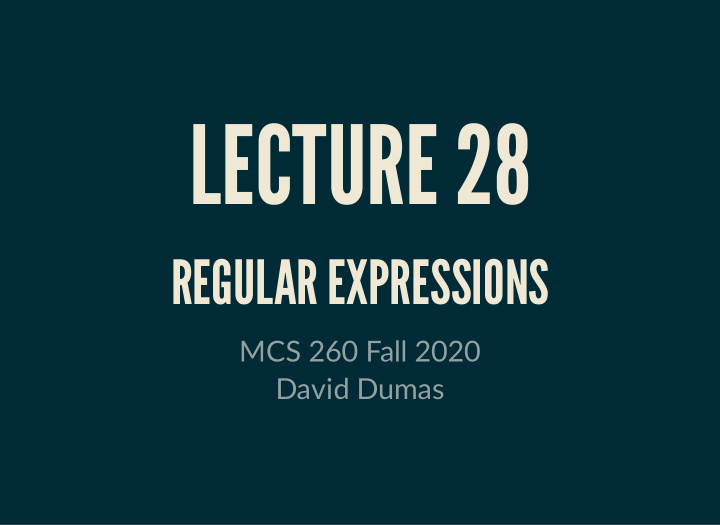



LECTURE 28 REGULAR EXPRESSIONS MCS 260 Fall 2020 David Dumas /
REMINDERS If you haven't started Project 3, you are behind! Worksheet 10 available Quiz 10 coming Thursday, due Nov 2 Nov 3: All UIC courses canceled (Elec�on day) Nov 5: Extra TA office hours instead of discussions /
LOOSE END: RECURSION PROS AND CONS O�en can solve a problem with recursion or with loops (an itera�ve solu�on). Why use recursion? Pros: Unclear: Cons: Short code Speed Uses more Clear code memory /
REGULAR EXPRESSIONS Today we'll learn about the module re in Python, which supports a text searching language known as regular expressions or regexes . Some of its key func�ons include: Searching for text matching a pa�ern Replacing text matching a pa�ern /
MINIMAL EXAMPLE Regexes are a mini programming language for specifying pa�erns of text. Dialects of regex are supported in many programming languages. We'll cover the Python dialect. Simplest usage: Find and replace a substring. import re s = "Avocado is usually considered a vegetable." print(re.sub("vegetable","fruit",s)) /
re.sub(pattern, replacement, string) The first argument of re.sub is a pa�ern . Unless it contains characters with special meaning in a regex pa�ern, the pa�ern just matches substrings equal to the pa�ern. "vegetable" matches the string "vegetable" "foo" matches the string "foo" /
RAW STRINGS Recall that backslash \ in a string starts an escape sequence in Python, and \\ represents a single backslash character in the string. If your string contains a lot of backslashes, you may want to disable escape sequences. You can do so by pu�ng the le�er r immediately before the quota�on mark(s). This is known as a raw string . In a raw string, a single \ represents the \ character. /
SPECIAL CHARACTERS IN PATTERNS . — matches any character except newline \s — matches any whitespace character \d — matches a decimal digit + — previous item must repeat 1 or more �mes * — previous item must repeat 0 or more �mes ? — previous item must repeat 0 or 1 �mes {n} — previous item must appear n �mes /
EXAMPLE PROBLEM Replace any price in whole dollars (wri�en like $2 or $1999 ) with the string -PRICE- . Note: $ is a special character. To match a dollar sign, use \$ . /
MATCHING AND SEARCHING What if you don't want to replace a regex, just find it? re.match(pattern,string) — does string begin with a match to pattern ? Return a match object or None . re.search(pattern,string) — does string contain a match to the pattern ? Return a match object or None . re.findall(pattern,string) — return a list of all non-overlapping matches as strings . /
MATCH OBJECTS If a match is found, then the match object has a method .group() that returns the full text of the match. .start() and .end() return the indices where the match begins and ends in the string. /
PARENTHESES A part of a pa�ern in parentheses is a group . A group is treated as a unit for operators like +,*,? . e.g. pa�ern (ha)+ matches ha or haha or hahaha but does not match Haha or h or hah . Matched groups are available from the match object using .group(1) , .group(2) , etc.. /
EXAMPLE PROBLEM Find all of the phone numbers in a string that are wri�en in the format 319-555-1012 , and split each one into area code (e.g. 319 ), exchange (e.g. 555 ), and line number (e.g. 1012 ). /
REFERENCES In Downey : Regular expressions are not discussed. Google's free online Python course has a unit on regular expressions. This course was developed for Python 2, so calls to print are lacking parentheses. Otherwise, the code should work. The documenta�on of the re module is good as a reference, not ideal to learn from. REVISION HISTORY 2020-10-29 Move unused slides to Lecture 29 2020-10-27 Ini�al publica�on /
Recommend
More recommend